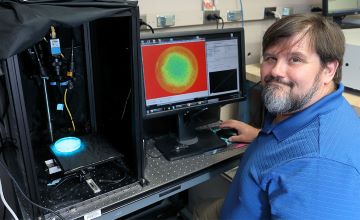NIH Mourns the Passing of George Patterson

IRP senior investigator George Harold Patterson passed away on June 20.
George Harold Patterson, a senior investigator and chief of the Section on Biophotonics at NIH’s National Institute of Biomedical Imaging and Bioengineering (NIBIB), died of complications from pancreatic cancer on June 20, 2021. He was only 50 years old, recently tenured, with a wife, two small children, and a promising career before him. We are just so sad about the loss of this warm friend and brilliant and creative scientist taken away far too soon.
George's research focused on the development of probes and techniques for diffraction-limited and sub-diffraction-limited fluorescence imaging of cells and tissues. Indeed, as a staff scientist in the NIH lab of Jennifer Lippincott-Schwartz, George worked intimately with Eric Betzig in the development of the nanometer-level resolution techniques that earned Eric a Nobel Prize in 2014.
George's research career started with his bachelor's degree from the University of North Alabama (Florence, Alabama) in 1992, which included a biology research project on the reproductive cycle of a freshwater mussel, Cyclonais tuberculata. In 1993, George was accepted into the Interdisciplinary Graduate Program within the Vanderbilt School of Medicine, Vanderbilt University, in Nashville, Tennessee, where he joined the lab of David Piston in the Department of Molecular Physiology in 1994. George was awarded a Ph.D. in 1999 for his study of glucose metabolism in pancreatic islets of Langerhans, which incorporated quantitative fluorescence imaging using fluorescent proteins.
George then accepted a postdoctoral position in Jennifer Lippincott-Schwartz's lab in the Cell Biology and Metabolism Branch at the Eunice Kennedy Shriver National Institute of Child Health and Human Development, where he developed reagents and techniques for fluorescence imaging in the study of secretory protein trafficking. He developed the photoactivable GFP (PA-GFP), a revolutionary tool because of its ability to be switched on from a dark state by a pulse of UV light, enabling the highlighting and tracing of specific subpopulations of proteins and organelles within cells, as well as selected cell populations over time.

Dr. Patterson’s research focused on the development of probes and techniques for the fluorescence imaging of cells and tissues.
Four years later, he accepted a staff scientist position there, where he continued work with PA-GFP and its uses in protein trafficking. During this exciting time, George collaborated with Eric Betzig and Harald Hess, then visiting scientists at the NIH with a bold idea for breaking the diffraction limit of light. George's 2002 paper with Jennifer in Science, titled "A Photoactivatable GFP for Selective Photolabeling of Proteins and Cells" was the main attractor for them to come to Jennifer’s lab. Together, the team developed photo-activated localization microscopy (PALM). George helped to make the photoactivatable genetically encoded proteins that made the technique viable.
"George's role went far beyond giving us space and PA-GFP plasmids," Eric said. "He tested the entire known universe of photoactivatable fluorescent proteins, found the optimum combinations for each target protein, and did all the cell culture, molecular biology, and transfections himself. The three of us [Hess included] routinely worked 15-hour days throughout the fall and winter of 2005, eventually submitting a paper to Science in March 2006." That paper, "Imaging Intracellular Fluorescent Proteins at Nanometer Resolution," was the foundation for Eric's 2014 Nobel Prize.
George subsequently developed other molecular localization techniques based on imaging of single fluorescent molecules along with multi-focal structured illumination microscopy (MSIM) techniques, which are based on exciting fluorophores with an array of diffraction-limited focused beams, followed by image processing to improve spatial resolution. In late 2009, he accepted an investigator appointment at NIBIB, where he worked on the development fluorescent proteins and on super-resolution imaging techniques for use in cell biology. He was tenured this year.

Dr. Patterson with his lab staff
At NIBIB, George made major contributions to create both novel and improved genetically encoded fluorescent proteins for use as markers and sensors. His approach utilized structure-based mutagenesis followed by spectroscopy and imaging characterization of the variants. His broad range of technique development included multi-photon excitation microscopy, confocal microscopy, total internal reflection fluorescence (TIRF) microscopy, wide-field microscopy, single molecule imaging, fluorescence spectroscopy, and protein engineering.
"In addition to being an incredible scientist, George was the kindest, most helpful and understanding person I've ever met in science," Jennifer said. "His story started as a farm boy growing up in rural Tennessee. In my lab, he created the photoactivatable GFP. Such a contribution was critical in helping Eric Betzig and Harald Hess make the super-resolution technique of PALM work. George was still young and had so much to offer."
Notably, George hosted a friendly laboratory with a large component of trainee diversity. George will be greatly missed by his colleagues in NIBIB and across the NIH. It is not an exaggeration to say that George was liked by everyone who knew him. We convey our deep condolences to George's wife Susanne, his children, Isabella and Max, and their entire family.
For additional information about George, see https://www.nibib.nih.gov/about-nibib/staff/in-memoriam-george-patterson.
Related Blog Posts
This page was last updated on Wednesday, July 5, 2023
